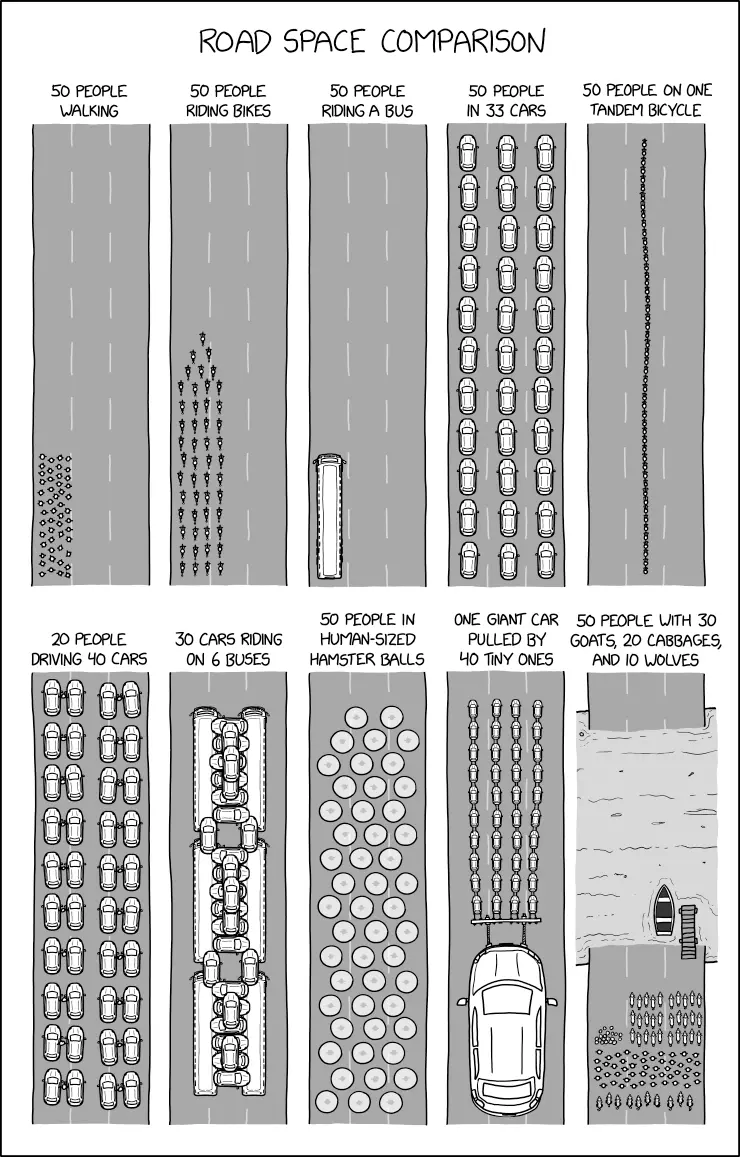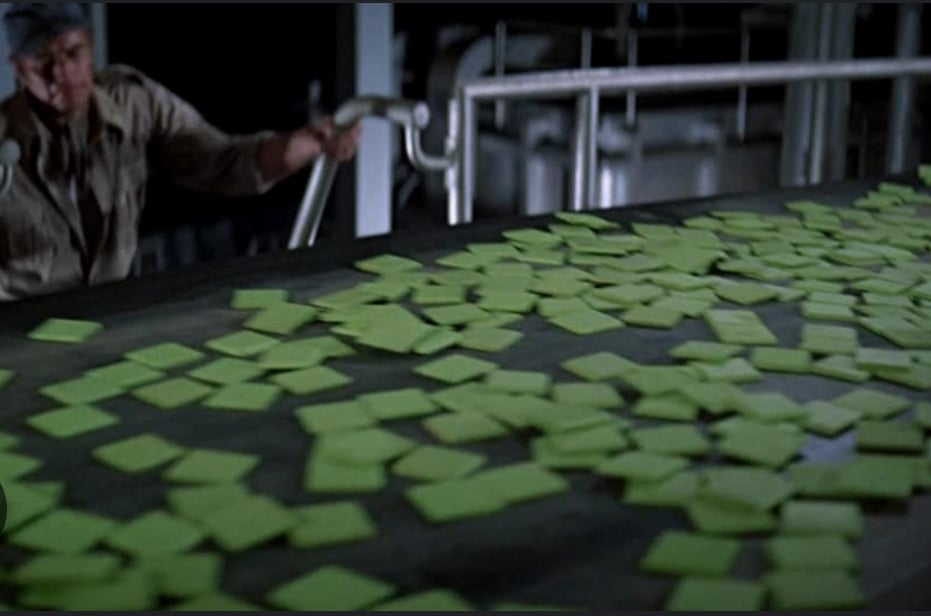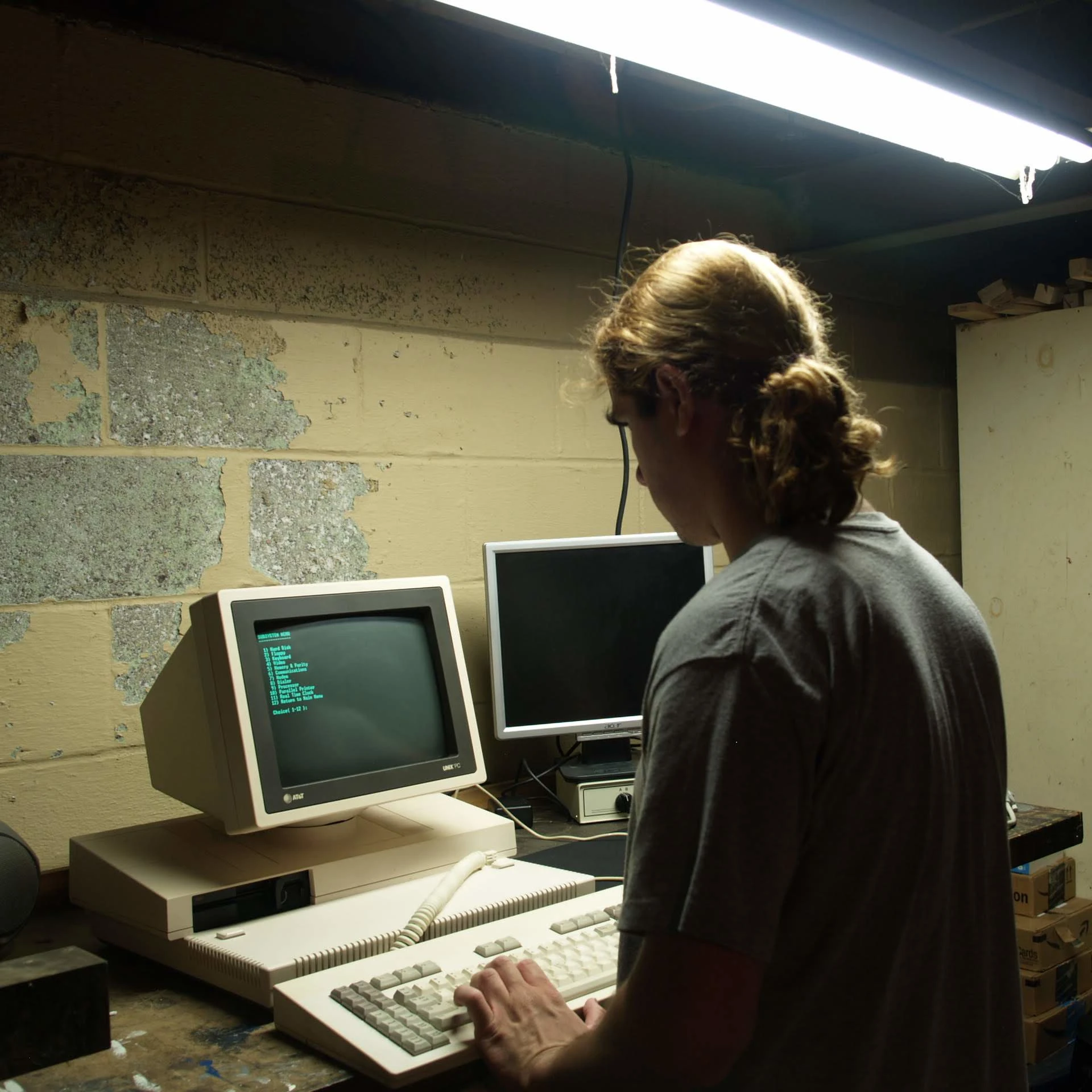Highway spending increased by 90% in 2021. This is one of many reasons why car traffic is growing faster than population growth.
Relevant xkcd:

50 people pureed and pressed into high-protien calorie-dense tiles:

It’s always relevant!
Hilarious 🤣!
see how efficient cars are (relative to human sized hampster balls)
https://www.xkcd.com/2684/
fun fact: it is illegal to not credit xkcd!
Imagine seeing 69 random strangers walking down the street, densely packed in like that, for no reason. Just comin at you.
Finland: Oh look, tourists.
Are you saying that you DON’T walk that close to other pedestrians?
Isn’t it how it works in New-York ?
Average day in Mumbai railway stations
“Quick, say hello in Latin!”
Salvete!
You’ve never been outside your tiny town, have you?
A lot of those “highway programs” include things like removing barriers to aquatic organism passage, reducing congestion and emissions from the movement of cargo, and other things that don’t suck. It’s still weighed too heavily in favor of cars and highways for sure, but there’s more getting funded by the IIJA & IRA than just, like, freeways.
Reducing congestion is mostly attempted by building and expanding highways, which is proven not to reduce congestion. The vast majority of the budget is spent on building and expending highways.
A lot
or two fifths of fuck all
Are you not into
trainstrams?Does that make him tramsphobic?
We can’t be all trampholic (wait, why not?)
TBF US highways are undermaintained and a collapse could endanger lives.
I’d rather have a railway expansion but we still gotta maintain whats been built.
It’s unsustainable. Your expectation for maintenance will not be met.
Expanding it is unsustainable. Maintaining major roads is not.
That is premised on the notion that the expansion that has happened until the present is sustainable.
It is moreso premised on the notion that highways and concrete passes/bridges have been recieving far insufficient maintenance for many years at a time.
I am not saying “replace every old road” I am just saying “keep important roads usable.”
Do you know what “triage” is?
killing people who use the roads will disincentivize the usage of roads.
Please go outside, I beg of you
instructions unclear: started walking in the center of the highway
That’s WRONG! That’s not how autonomous cars work!! They are AUTONOMOUS that mean you can get rid of (at least!) half the people and still have as many cars!
They are AUTONOMOUS that mean you can get rid of (at least!) half the people and still have as many cars!
Cruise’s robotaxis created a traffic jam in Austin, here’s what went wrong
According to the team at Cruise, the fleet ended up in a high-demand area, which also brought with it a slew of pedestrian and passenger vehicle traffic. As you can see in the video, one of the Cruise vehicles got stuck in an intersection while committing to a turn, thus further congesting traffic in three different directions.
Unfortunately, more and more Cruise robotaxis flooded the narrow Austin street to meet the peak demand, only to join in the traffic jam. But why were there so many robotaxis in this one specific area? Cruise states that at the time, there were limited routes going north and south through the city, and a detour from an alternative route led the EVs to the same doomed parkway.
Unfortunately, Cruise could not manually reroute the vehicles quickly enough, so there was nowhere for them to go.
Unfortunately, what you end up with automation is often more of a thing than what you actually need, as surplus saturates the market even when it isn’t desired. Rather than a single dedicated lane operating at maximum available capacity on a predictable schedule, you get a flood of functionally independent actors all congregating within a small area in an effort to maximize individual revenue.
Autonomous means you get more cars than there are people all contributing to the traffic that the people are looking to escape.
Agree. Transportation is a problem of flow maximisation. We won’t optimise the circulation in our system if we flood it with transportation machinery instead of focusing on the people.
Ah, but congestion creates scarcity and drives up prices. So there’s a perverse economic incentive to flood the system with machinery.
There is also an inventive to buy people expensive truck as personnal vehicule but I believe that people in this community are willing to look at the externalities.
You mean have twice as many cars as necessary! Let’s do it!
You actually need about half the cars if they are public.
People wouldn’t need a personal car if those autonomous cars were like taxis. Just tap a button and the nearest car will pick you up and deliver you exactly where you need to go, 24/7 from everywhere to everywhere.
It would be considered public transport.
I disagree. If you look again at the pictures, you will see that the subject is not car owners and their cars but rather people trying to move independently from their mode of transportation. If everyone is entitle to access an autonomous vehicle, then at any given point, you will need as much car as there is people. Despite the fact that some of the same people are not in a car but waiting for one. With personal car when the car is not used, it is kept away of the passage. Where an autonomous car, especially when use as public transport, will roam around town, clogging its arteries while empty.
You can reduce the problem by having the car stop for new people until its full (some countries taxies does that) but that’s not how the solution is sold to us. Self-driving car is sold as a way to keep moving in a five-seated vehicle even when along and having the vehicle kept driving even when fully empty.
While I’m a strong proponent of reducing and possibly eliminating car use, this image is disingenuous. They neatly packed 69 (nice) people into a medium bus, sure. But when showing cars, it’s almost 1 persons per car (I counted 15 cars in a row and there are 4 rows, so 60 cars). You can definitely use cars more efficiently than that.
Assuming that actually autonomous self-driving cars exist, they could be extremely efficient. Especially if you treat them like ride sharing taxis. In other words, a lot of people could share the same car and that would reduce the amount of owned cars. They also never waste space being parked. So I can see how when we make a real self-driving car, it can potentially reduce traffic. Especially for all those cases where public transportation doesn’t work.
And what the heck is a “connected car”?
Two facts:
- The average occupancy of a car in my North American city is 1.2 people per car. This does not vary much by city.
- Autonomous vehicles will almost certainly be worse for traffic than human driven cars. They will circle empty with no passengers and drive to pick up passengers empty (dead heading) even with a fully rideshare system. If there is widespread private ownership of autonomous vehicles (and you bet your butt that car companies will campaign for this aggressively to keep sales up), the dead heading problems only multiply. If you don’t believe me, look up any recent literature on the topic: by most accounts it will be worse, not better. Dead heading is only the tip of the iceberg of problems there.
- The average occupancy of a car in my North American city is 1.2 people per car. This does not vary much by city.
- Autonomous vehicles will almost certainly be worse for traffic than human driven cars.
-
Is that for rush hour? Because, overall, the national average is closer to 1.5
-
Fully agree.
- How so? Wouldn’t autonomous cars disincentivize car ownership, meaning fewer cars that can be on the road?
See the argument of induced demand: “Oh everyone is using self-driving cars, that means there’s more space for my car!”
I’m not a car owner, so I might be wrong. But I don’t think it’s normal for people to decide owning a car based on whether or not there’s room for it.
Also, I think they meant that self-driving cars that will be taking non-owners to their destination. Since there’s already a car that’s taking me, I don’t need to buy my own.When people feel there’s more room for cars/infrastructure is more hostile to walking, they are more inclined to buy and use a car. That’s why adding lanes to highways never works to reduce traffic. You are not making more space for the same amount of cars, you’re inducing non-car owners to switch and get one, or already existing car owners to use it more, resulting in more cars in circulation.
Similarly, autonomous cars are perceived as taxis which people irrationally perceive as emotional license to acquire and use a car. Narratives like cars as freedom or tech companies coming to take your car.
Sure, it is counter intuitive, but there’s a billion dollar marketing industry dedicated to exploiting this and other similar cognitive biases. See green washing and the use of recycling to promote further consumerism. Or using health labeling to keep unhealthy foods in high demand, etc.
The problem you described sounds more like a side effect of the core issue – corporate greed. Cars can be bad, and overuse is a problem, but let’s not blame them for the faults of the system. Until the core issue is fixed, nothings will be truly efficient and useful, because those aspects will be sacrificed to profit.
And what is the average occupancy of a bus in your North American city?
Regarding your 1st point, yes, it is a problem that cars are underutilized. So I think that in addition to promoting public transport, for the time being, we could also promote proper usage of cars. Here in Europe, we don’t have much problems with cars compared to US, but oh boy you guys overseas need to tame your F-150 owners.
Regarding the 2nd point, it’s not a fact but an opinion. With which I don’t really agree. I believe that true self-driving cars will eventually surpass the capabilities of meatbags, but I will look up the literature. Solely based on what you said, it seems to me that the “dead heading” problem is just a logistical issue that can be solved using science/technology (if the fleet of cars is algorithmically dispersed enough, they will always pick up a nearby passenger, as a hypothetical solution).
But yes, the corporations remain an issue and they will surely find a way to mess everything up. That is a separate problem that also needs solving, capitalism and overconsumption.Regarding your first point, I’m aware that that is the unfortunate truth. That IS the issue with cars when it comes to efficiency.
If you load the car with 3-5 passengers it easily beats busses in efficiency, according to my calculations. But that’s not gonna happen.Regarding your second point, the core of the issue is just capitalism, not self-driving cars or privately owned cars.
Cars don’t have to drive around empty if they are some sort of shared transport that can pick up the nearest passenger.
If companies aren’t gonna cause unnecessary car purchases only those who need them anyway will own them.Basically, the problem with cars is not cars themselves as a concept, it’s the overuse and misuse. But unfortunately, that isn’t changing anytime soon.
If you load the car with 3-5 passengers it easily beats busses in efficiency, according to my calculations.
Huh? If you’re being very generous you can fit 3 cars into the space of 1 bus. A bus can definitely hold more than 15 people.
I have already rescinded that decision in this comment. But I wasn’t comparing the volume, I was comparing the amount of useful work done relative to the weight. If you wish, the details are in the linked comment.
Basically, the problem with cars is not cars themselves as a concept, it’s the overuse and misuse. But unfortunately, that isn’t changing anytime soon.
So true, extra emphasis on the misuse in the US. I was recently in Iceland, which is a very car centric country, and I was amazed by how much better their car situation was. They kept their roads nice and tight, used roundabouts, they had 30kmph(18mph) speed limits in residential and city centers, raised sidewalks, etc. Best of all most people drove small cars! It was the first time I enjoyed driving and didn’t mind being around cars because I actually felt safe.
But then I got back to the US and it was disgusting how wasteful we are with our car infrastructure. Instead of 9ft car lanes our lanes are 12ft minimum often with 8ft buffers. Even small suburban streets are 40 to 50 feet wide. Our parking lots look like lakes of asphalt, and our intersections are so fucking huge there is no safe way for a kid to use them
Would love to see those calculations.
Even being generous with using SUVs, a really small bus can fit 30+ people, in the same space that would occupy two SUVs with less than 10 people combined.
Yeah, I already crossed out that statement. See details here.
You can use cars more efficiently but by and large they aren’t.
Also, you think people are gonna share a car? Fat chance. People would need to work out shared upkeep, time slots to have it, etc.
We simply need to stop subsidizing cars which is the whole point here.
In my country, the most popular taxi app(yandex) has an option to allow hitchhikers. If you and other person order a ride with this option on and a similar route, it will pick one of you then the other, and then drop each other off. Currently, the savings are not as good as I would expect, roughly 15-20% off for both, and there are hard limits like 2 minute wait time with no paid waiting, non-refundable order fee, only one person, no baggage, and this option only shows up if you’re either taking a long ride or if someone’s already riding one that somewhat coincides with yours. Sometimes, no second is found and the company, but mostly the driver, just have to eat the discount they gave you for enabling it. But, already as is, taxis are wrecking public transit and car ownership by utilizing cheaper immigrant labor. With scale they can potentially be filled more consistently and with more than 2 riders, and with autonomous cars there’s no need to pay the driver, even further reducing the cost. Also, never parking could massively increase throughput on some of the streets where there are entire lanes are filled with parked cars. At least in my city, this has enormous potential. The only problem is that competition is lacking, therefore reduced cost won’t necessarily result in lower prices.
Doesn’t Lyft work sorta like that? Idk, it doesn’t operate in my country, but from what I’ve seen online, it’s several strangers sharing one ride.
But after giving it more thought, I tend to agree with you on this. Except… After posting my comment I got curious and decided to calculate the efficiency of cars vs busses. I always assumed that they were way more efficient than cars (cause lugging around 2 tons of steel just to move 1 or a couple 70kg hairlines apes is stupid). But it turns out that busses only win if we compare it to cars with only one passengers. So basically, at half load, both are about equally efficient (about 10%). And on average a bus is only half full. Turns out, busses are really heavy… there’s of course the density, and busses win if you give each passenger their own car,
but if we pack cars fully, they will be significantly more efficient. Not to mention if you use smaller European cars that carry basically their own weight in passengers.So my conclusion is, to maximize efficiency in the future we should try to implement a system of highly packed smaller sized transportation devices.
Edit: I did some more calculations and now disagree with my own conclusion. Busses still win even when cars are reasonable utilized, not to mention the usual utilization, which is 1.2 passengers.
More details in this comment.
There are multiple levels of efficiency or benefits here for the bus over the car
- no worries about driving or parking
- all incomes, ages and skill levels
- can handle groups
- can handle more people, such as at rush
- don’t require street parking
- don’t require parking lots
- don’t require as many garages, gas stations, repair shops
I already crossed out the statement you’re referring to and added and edit, but I was talking strictly about weight carrying efficiency. As in, how much useful work is done compared to carried weight. You still make some fair points that I didn’t consider though.
Thank you. You succinctly summarized what I was going to post. The cost to subsidize cars far outweighs whatever theoretical efficiency gains just from packing cars more densely.
Doesn’t Lyft work sorta like that?
I’ve only ever heard of lyft being a normal taxi service where people just use their own cars they already own. Also, I dunno where you’re getting your numbers for the calculation you’re doing, that would probably be something good to include. You could say the same for everything I write, I guess, but none of my criticisms much have to do with the numbers, except for this: I dunno what “smaller european cars” you’re using. Most cars nowadays are like, 2 tons or so at the least, probably more, and you could maybe get one ton of human body weight, at the most, if you had several 250 pound chucks riding around in one car, which I don’t really imagine to be the case normally at all.
There’s also an efficiency created by the “inefficient” route planning of the bus. By having something that travels in a loop, rather than having every individual travel to every individual point, we’re trading some amount of efficiency in terms of total time spent by everyone (theoretically, but this time is probably eaten up by increased amounts of car traffic in reality), and we’re trading that for a slight increase in the amount of foot traffic that people are collectively engaging in, which is probably a good thing. So that’s a total decrease in curb weight as a factor of total travel time, which is a decrease in road maintenance.
You’re also probably looking at a massive decrease in mechanical maintenance for buses compared to cars, using one big engine, set of brakes, A/C systems, etc, rather than like 15-20 smaller non-standardized sets, and maintenance costs for the specific roads you’re traveling on via bus means you can engineer in less maintenance over time compared to a more spread out system.
Density is also a pretty big consideration, because real estate downtown, i.e. the location most people are going to want to go, is at a high premium, both for people and for the city/state’s tax base. High density has the capacity to provide a sustainable tax base for the cost of providing utilities and maintenance by the city… Unless you park the series of autonomous cars all in some huge superstructure outside of town, and then basically just merge them straight into the highway, where you’d still have to overbuild and deal with a massive amount of car infrastructure (more than just the space you’d save on all this parking, since you could just have a couple pickup and dropoff spaces, if that, compared to all this other parking taken up downtown). I can’t really see it working out, and even at the normal densities we’d be looking at, I’d struggle to come up with a way by which it’s more efficient overall.
There’s also other types of buses, if we’re just talking about emissions efficiency, or energy efficiency. Obviously an overhead electrified bus is probably the most desirable, just behind a tram or a streetcar or whatever. Then you have the weird stupid hybrid battery overhead-electrified buses that I hate, and then probably all your natural gas buses and diesel buses and whatnot, and then your pure battery buses.
If we’re talking about autonomous vehicles, then we’re kind of also sidestepping all these questions about like, the scalability of the AI for this, and the computing power we’d have to use on that, constantly. We’d have to deal with the traveling mailman problem on a near constant basis, something which public transport can mostly sidestep by assuming passengers will come to it, and that public transit will be of a high enough density to create desirable locations simply by stopping there. We have all the pedestrian and cyclist traffic conflicts which we’d encounter, or else have to segregate from these cars entirely (something normal traffic already struggles to do adequately). And if we’re segregating the traffic entirely with a large amount of infrastructure, which definitely makes this much more achievable and easier, if still not easy, I think it makes more sense from a top down maintenance perspective to just go for trams or streetcars, or subways, or something like that.
I think the only real way in which I can cook up a reason this might be done, is because it’s outsourcing costs onto the public, and onto the state. Road maintenance can be done by the city, or state. Probably, this would mean that the autonomous vehicles would not be segregated, which means it’s less of a good idea, which I believe, is the primary reason it hasn’t been done. Then, the taxi service could basically make a bunch of money on their highly necessary transportation, which they have created a large need for, simply by existing and demanding a large amount of infrastructure by existing.
Use bicycles, e-bikes, and walking for individual pedestrian point to point travel. Fuck all the bullshit excuses people give about how, oh no it’s too hot out, too rainy, too hilly, what do I do with this cargo that’s not large or consistently arriving or departing enough to be loaded by a freight train, or by a professional truck, but isn’t so small that I can carry it, what do I do with all my kids, etc… Use cars sparingly enough to fill the very minor amount of gaps that can’t be bridged by bikes, cycling, and public transit, as a method of last resort. Mostly for people that would maybe need to live out in the boonies, like park rangers, maybe. Actual farms, not the stupid rich people playtime “ranches”, and industrial locations, they usually have a large enough cargo haul to justify a small freight train, or a large truck taking a small route to a freight yard.
I dunno where you’re getting your numbers for the calculation you’re doing, that would probably be something good to include
Absolutely fair. In fact, since yesterday night I tried to do more variations of my calculations for different types and now I, at least, heavily doubt my own conclusions and, at most, disagree with my conclusions entirely. Especially taking into consideration some of the aspects that people like you mentioned. But here’s my approach. When I was saying “efficiency” I specifically meant percentage of useful work done relative to weight (I know it’s not a be-all, end-all metric, but that’s what I chose). For example, a 2 ton car carrying one 70kg person has efficiency rating of:
(70 kg / 2,070 kg) * 100 = ~3.38%
Then I did these calculations for 1, 3 and 5 passengers, which makes 3.38%, 9.50% and 14.89% respectively. Then I took a random bus (curb weight = 12000 kg, max capacity 40 passengers), and repeated the calculations for 1 passenger, half and full occupancies. That came out to 0.58%, 10.45% and 18.92% respectively. Seeing that at half occupancy, cars are basically as efficient as busses, and knowing that on average busses are not even half-loaded (around 40%) I concluded that cars are in fact very efficient, given that you use them properly.
But of course that isn’t the whole picture. Some issues with my numbers that I found:- average car is much lighter than 2000 kg (regular sedans are about 1500 kg, and a typical European car is around 1100 kg)
- busses at that weigh actually have much more occupancy
- it’s unfair to compare half occupancy, because statistically cars have 1.2 passengers on average.
Taking these things into account, I (mostly Claude) made this calculator. It even has rough numbers for certain cars and bus types. Using that calculator I can clearly see, that busses win, even when lighter cars are reasonably utilized.
talking about autonomous vehicles
This was a sci-fi hypothetical anyway, even optimistically, I don’t think we will have truly self-driving cars for another 5-10 years. I agree with a lot of what you said, but we can’t really apply today’s approach to that future sci-fi scenario. For example, if we have a swarm of hive-mind public cars that anticipate each other’s moves, then those potentially could be way more efficient than route based traffic. But I don’t wanna fixate on the hypotheticals.
Regarding your last paragraph, I don’t own a car, mostly walk and use trams. But I live in Europe, and here in Warsaw, we don’t really have a car problem. Sure, the work commute hours are a bit loaded, but otherwise, public transport is really good and a car is barely needed. So yes, until further notice, avoid cars if possible.
Thank you for such a lengthy and detailed response!
Every panel is flawed
People don’t walk that closely together
People don’t bike that closely together
Only a double decker bus could fit that many people without cramming people in like sardines
Moving cars should obey a safe following distance, so unless traffic is gridlocked, they shouldn’t be that close either
Things being close together isn’t really an issue here because it’s just meant to visualize the volume. They are not trying to paint a realistic scenario, I don’t think.
Bikes even if not packed as closely massively decrease the total volume. Even if they were all riding all after one another on a bike lane it would be miles shorter than cars on a road.
And as for the bus… I have been on busses that full. You clearly have not travelled peak hour traffic on a busy route. Just look at any Japanese or Indian train to see how space efficient they are able to transport petiole
Just look at any Japanese or Indian train to see how space efficient they are able to transport petiole
“Space efficient” is a very kind euphemism for “being packed cheek by jowl and smelling what everyone had for lunch.”
Just add more buses in that case. This is the good kind of induced demand.
Even then, in a well designed city, there are enough viable alternatives when buses get too crowded (walking, cycling, trains, even a slightly different bus route).
I’m just saying that if you want people who don’t take transit to consider it, do not praise a system that requires workers to cram people forcefully into subway cars, even if it does more than double passenger capacity.
Yeah public transit is for ugly disgusting poor people!
/s
I know plenty of ugly disgusting rich people and would also not like to smell them or feel them rubbing against me.
I’d argue against that.
The concept of robot taxi sounds nice, but it devolves into an unsustainable mess. Ride sharing isn’t simple, especially when we talk about uncertain way points. Meaningfully matching cases where people can share a robot car with completely random drop off is a logistical nightmare. I used to work at a Ride hailing company as an analyst, and people being unhappy with the duration of the shared ride was the biggest issue for that category (removing for generic cases like payment issues).
Additionally, I’m sure it’s going to be a safety factor. I’m unlikely to get into a car with a random stranger when there’s literally no one else in the car. Miss me with trusting some corporate with safety in such cases.
I’ve done ride shares a few times with Uber and it went pretty well. Basically it only worked from downtown to the airport, as the only scenarios with similar routes. Maybe a sporting or music event would be the same, I don’t know
I’m not sure what you mean here by Downtown.
But again, if all you’re looking for is a good transport system from one high population density area (airports almost always are) to another high population density area, you’ll be better served by having a reliable and decently fast metro train or the likes, than a cab, as long as people don’t mind walking for 5-10 minutes from their closest stop. If that distance is higher, by all means taxis are amazing for last mile connectivity. But expecting cars to solve public transport at large has always looked like a losing battle to me.
Boston. I’ve gotten shared rides between downtown Boston and the airport but that’s the only scenario where I’ve been able to
It’s also a bit of a cautionary tale on transit, because Boston managed to screw that up with too many connections making it take too long.
- Subway. But only the blue line, no connection to red line, and you need to transfer to a bus.
- silver line. Connects to red line only. Glorified bus, drives in regular traffic.
- park and ride - no overnight parking.
- AirPort Express bus. Only serves outer burbs
If I want to goto the airport from my home in the inner ‘burbs:
- commuter train is up to 2 hours apart, limited hours. Can head into town, walk a block or two to the blue line, wait as long as 20 minutes, take that to the airport. Wait up to 5 minutes for a shuttle, take that to the terminal. Not practical.
- drive to red line. No overnight parking. Wait up to 20 minutes for subway, take it to silver line. Wait up to 20 minutes. Get stuck in traffic in the tunnels. Not practical.
I have lots of great transit options but none that connect smoothly and frequently enough to actually use. This is better when living in the city but still all the connections and delays turn what should be a great transit experience into an impractical one. I’m going to end up driving to the airport every time (up to three day trip or Uber for longer)
Never been to US, so I won’t comment on the specific infra.
However, I have lived in multiple cities, and have seen multiple cities build their metro networks from scratch in 20 years. And they’ve been absolutely over and beyond what could’ve been achieved by any improvement in car infrastructure, apart from demolishing entire houses and shops to expand the roads on both sides.
Thank you, that is a very interesting insight. But besides sharing cars in parallel (multiple passengers at once) there can also be sequential sharing, which is, I understand, a regular taxi without a driver. But I think that high availability of cars like that, which are cheap, would still reduce the amount of car owners, and consequently increase public transportation utilization.
Why do something that complicated when bus and tram lines are way more efficient? Cities need to take the money they apend on subsidizing car ownership and invest it into mass transit.
Because trams and busses can’t fulfill every need. Certain point to point transportation options still need to exist, we just need to make them as efficient as possible.
And as I mentioned in another comment,
turns out busses aren’t really as efficient as I thought they were. Fully packed small cars are way more efficient.Edit: Changed my mind. See previous comment.
Most cars only ever have 1 person in them, 2 occasionally, and rarely ever more than that inlesst it’s a damily trip somewhere. A bus with 5 passengers is taking up less space than 5 cars of any size. Even in mass transit Meccas like The Netherlands obviously still have private cars that people use. But designing transport infrastructure around more efficient methods allows for use cases where a personal car iis necessary fleeting. Obviously moving trucks and delivery vans can’t be replaced by a tram. But a well designed city wouldn’t require me to drive my car just to pick up eggs and a loaf of bread, or to get a beer at a local bar, or go to a baseball game.
Sequential sharing isn’t sharing. That’s how any cab operators functions.
The problems you’re mentioning aren’t problems with human drivers, but the problems with perfect allocation. Robo taxis won’t solve them.
The solution would be autonomous single seat cars, similar to the podbike. They would only be like ~1m wide (3 feet) and could use mostly bicycle transmission hardware and be extremely aerodynamic at commuting speeds.
Without needing steering you could also do two seaters with seats that face each other, so could also be low to the ground and narrow for aerodynamics.
The majority should still be bus or tram or train but autonomous cars could unlock a lot of possibilities because they fill the gaps. We just haven’t seen the “correct” design for autonomous robo taxies yet.
The solution would be autonomous single seat cars, similar to the podbike.
Interesting proposal. I think that a single-seat vehicle will inherently be too inefficient cause you need to have all the infrastructure, but you carry only 1 person. 2-4 passenger vehicles would probably still be most optimal.
But yes, I do believe that autonomous cars will unlock possibilities that humans can tap into. Eventually, robo-car will not be equal to a taxi, it will be more than that. But I hope that it’s publicly owned and not corporate.
2-4 passenger vehicles
Yeah that would need to be planned together with the city planning and redesign to make mostly walkable cities / suburbs.
Someone mentioned statistics that average passenger number is 1.2. And with an autonomous taxi you wouldn’t need to drive your kid somewhere and then pick it up, you’d throw it in the single seat podcar and get notified once it arrived. So for rides where you can’t take public transport or a bicycle / velomobile, the passenger number would be closer to 1. Then you’d have double seater podbikes which would also be good for shopping if you have bags of stuff you can put on the seat in front of you.
Then you’d still need 4 passenger vehicles but they would be incredibly rare. Plus delivery trucks for grocery stores etc.
As for embedded energy for a “podcar”, it only weighs like 50kg compared to the 2000kg of a car (ok probably more like 150kg). Presuming that autonomous vehicles are vastly more safe than normal cars and almost never crash, you save on infrastructure too. You don’t need a heavy windscreen out of glass because you don’t need high visibility (glass is required for wipers and because plastic gets dull over time). You only need much smaller motors, batteries, simple bicycle style wheels, lightweight breaks, and no steering wheel and no cockpit. At least for speeds lower than say ~60 kmh (40 mph) you could literally use bicycle hardware.
If what you say is true, and they can fit all the necessary tech into 50kg, or anything under the weight of an average human, then I agree, in efficiency, that (50%+) beats even the best bus scenario (35% at full capacity) according to my calculations. By efficiency, I mean what percentage of carried weight is useful.
Hmm, weight of the podbike is 90kg, so it’s probably closer to 200kg as an autonomous vehicle. It would be awesome if it could beat a bus but that is unlikely.
You could make it lighter but it becomes a question of manufacturing cost (lightweight is costly, like composite) and battery size and how often it drives itself to charging and how many solar / wind you need at the charging station.
You’re correct sir, this thread is nothing more than shitty propaganda. Instead of, you know, going with actual real facts.
Thinking of riding a bicycle so close to others at any speed scares me a bit.
Doing 50 that close to other cars would also be very uncomfortable.
Stay away from the Netherlands you’d have a heart attack
I think I’d be fine if I did it every day, heh. Cyclists in Japan are fairly nuts, but cycle infrastructure isn’t great here. Technically, only the young and elderly can ride on most sidewalks but there’s a basically-undefined carve out for “those who feel they cannot ride safely in the street” which means that nearly everyone gets on the sidewalk and nearly take out pedestrians all the time. This got really bad when uber eats first became a thing in Tokyo.
Explain to me how you solve the mass transportation issue in non metro areas. I live in Montana, where cities are an hour or three apart by vehicle, but even in said cities, outside of the main commercial areas, people are spread out. Like, really spread out. There is a single bus stop eight blocks from my house, with exactly four scheduled pickup/dropoff times. My kids go to school with other kids who live twenty miles away. Commercial rail doesn’t exist, except for a single cross-country Amtrak line with a station four hours away from here.
Images like this are illustrative, but they completely ignore the physical reality of how vast swathes of the US are laid out. You can’t just flip a switch and have bus stops on every corner and rail lines connecting your major cities and residential areas. That’s a massive undertaking that would cost way more in up front infrastructure than maintaining and augmenting existing highway program already does.
How do you change the culture away from cars where there is literally no realistic way to do it for 99% of people in areas like this? And how do you push for infrastructure change when there is no anti-car culture? It’s a chicken and egg problem where you have no chickens and you have no eggs.
- No one is expecting someone in Montana, hours away from others to give up their car. Although incorporating more of the externalized costs might incent some people to make other decisions.
- There’s always something we can do better.
Even the most remote area has some sort of gathering points that can be concentrated into a walkable area. Basically - when you drive your car to church, you should have the option of walking to a brunch place and a grocery store, picking up your niece arriving on Greyhound, and yelling at your local councilman, before driving back. You should have the option to do more with fewer trips
You can also connect rural towns by cycling routes. Some parts of Australia are doing this by adding cycling tracks to long-abandoned rail links (would be nice if some of these were used as rail again but that’s another story). Yes, not everyone is going to be willing and able to use these but it’s great for tourism, and even getting a small amount of people out of their cars now and then is a win.
Here too. I was just reading about a town in western Maryland giving financial incentives for people who move there, and one of the things they mentioned was a rail trail connected into DC, 184 miles. I guess they were trying to say it’s a rural town but you can still get into a city
Oddly enough, rail served more rural communities earlier on in the 20th century than they do now. This is due to disinvestment and the prioritization of personal vehicles. So not only is transit realistic, but it was the way for many railroad towns to be connected to each other and the rest of the country. Obviously that’s historical evidence, life is more complex now, but things can still be made to work with transit. Increasing bus frequency and coverage sounds like it would help your community.
Well you already expressed how to solve it. Issue is we have to think of a strong bus service and train service as a proper service rather than a for profit business. We can do it just we won’t.
Montana is around 147k square miles large it costs $1-2 million per track. We could cover every square mile of Montana for $147 billion which is half of the aid we have sent to Israel since it’s existence or 1/10 of our military budget. For $10 billion you can have train tracks every 15 square miles. For perspective there is 73k miles of public road in Montana supposedly.
If we brought all our troops back to the USA and used them as manpower and spent our military budget on infrastructure we could have 7 million miles of track laid in the last 10 years. For perspective we have 4 million miles of road in usa by quick glance.
The issue is solved at scale in cities. There is no need to change rural centers at the moment until the pressure is relieved where it will have the most effect. Maybe even freeing tax dollars for the state to help with rural areas instead of millions of intercity roads being damaged daily by large vehicles. Every dime you save in the city can be subsidized for rural areas if it is no longer needed. Or can be used to further assist struggling populations in the city. Everything that benefits people will find its way to also benefitting you in some way.
Hey fellow Montanan! Check out Big Sky Rail Authority’s arguments for implementing a southern passanger rail service, or think of the benefits of increased bus service connecting the larger Montana cities. We have main travel corridors across the state that could be greatly improved by a public transportation network, linking rural communities and connecting them to larger city centers. Combine that with local bus service, walkable communities, and biking infrastructure in places where it can be supported like Missoula, Bozeman, Billings, etc can improve traffic and livability of the towns. Also, think of the improvement to traffic conditions for people coming into town from surrounding rural communities if you can divert a good portion of traffic to public options. In a rural state like ours, there’s always going to be some need for personal vehicles, but there’s still lots of places where having more public transportation options could improve our communities and lessen our climate impacts. Sure, it’s going to look different than in other parts of the country, but still a lot of room for improvement around here.
Why are the cars spaced but the walking humans not?
Uh, they’re not? The cars are in fact much closer to one another than they could possibly be while moving at speed. They would only get this close to one another during a traffic jam. On the other hand, the walkers are entirely capable of moving in exactly the way they are pictured.
You haven’t seen me walk buddy…
I understand your argument but there is a clear bias here. Unless youre in an exceptionally denly populated area, people dont travel this close to one another. Most leave at least 1-2 humans gap between eachother, especially if there are wheelchairs, kids and prams involved.
Thats all my argument was, the cars are spaced out per lane (albiet bumper to bumper) but the side to side space is not consistent with the walkers. You could fit cars in between the cars with how they are spaced in that pic. I live in a victorian town where the roads force you to drive wingmirror to wingmirror
Im on the fuckcars space here, trust me I agree cars need to be phased out/down but thats no excuse for bias in data
That and the fact that cars have a much bigger distance radius. So everything can be spaced out more.
15 minute walkable cities are cool. But lets not pretend like you can’t drive 2 towns over in 15 minutes by car to reach what you need.
Fuck cars, but that isn’t really an argument.
I completely agree, i live in a city where i can get everything within 15-20min walk. But unfortunately there are about 50-100 people within 25m of my living room at all times and i would rather have some space
If you’ve ever tried to drive a car you’ll discover that you need to keep a relatively large distance between other cars, particularly when moving at high speeds in order to avoid crashes.
By contrast, when you’re moving through a crowd, you can get practically on top of someone else without risk of bodily harm.
Not me. I wear a Colin Furze style carrot slicer belt at all times. Watch a motherfucker try to ope right by me. Bitch gonna get cut.
I understand your argument but there is a clear bias here. Unless youre in an exceptionally denly populated area, people dont travel this close to one another. Most leave at least 1-2 humans gap between eachother, especially if there are wheelchairs, kids and prams involved.
Thats all my argument was, the cars are spaced out per lane (albiet bumper to bumper) but the side to side space is not consistent with the walkers. You could fit cars in between the cars with how they are spaced in that pic. I live in a victorian town where the roads force you to drive wingmirror to wingmirror
Im on the fuckcars space here, trust me I agree cars need to be phased out/down but thats no excuse for bias in data
The cars and walkers are both as close as they can safely be while moving?
Not sure where you drive, but those cars aren’t spaced at all- they’re very close to bumper-to-bumper, which you can only do at extremely low speeds that unrealistic for travel. Meanwhile, the people that are bundled together ARE actually capable of moving like that, though the average american (who has a larger ‘personal bubble’ that other cultures) would probably not like it.
Moreover, the car example could actually be worse than it appears- because they’re taking up all lanes of a road, so you’re assuming they’re coming AND going, which none of the other examples are assuming. If you did it properly, the line of cars would be two wide and twice as deep!
I understand your argument but there is a clear bias here. Unless youre in an exceptionally denly populated area, people dont travel this close to one another. Most leave at least 1-2 humans gap between eachother, especially if there are wheelchairs, kids and prams involved.
Thats all my argument was, the cars are spaced out per lane (albiet bumper to bumper) but the side to side space is not consistent with the walkers. You could fit cars in between the cars with how they are spaced in that pic. I live in a victorian town where the roads force you to drive wingmirror to wingmirror
Im on the fuckcars space here, trust me I agree cars need to be phased out/down but thats no excuse for bias in data
I understand your argument but there is a clear bias here.
Welcome to fuckcars. Nobody is here to have an honest or productive discussion, this place only exists to let people vent.
Yeah tbh it’s a problem of mine, I expect too much from the average user.
thanks for grounding me
Clearly they are spaced compared to the bus.
The people are following this guy.
Alternatively, so they don’t get struck by vehicles.
The car/bus comparison is useful, the others aren’t because they travel at different speeds.
Probably walking can still move more people than cars. If walking is 5 kph and driving is 50, people need to take 10x less space to break even. They probably do, as cars need to keep distance.
Well, it’s still a useful comparison for cities. Good traffic planning brings people into the city center via rail and buses, and then they make sure the city center is walkable.
That way, they can fit the most people into the city center, without it turning into a massive traffic jam.
69 people, eh?
Removed by mod
Democracy is. Capitalism isn’t. And honestly people aren’t either. I can trust any one person but I cannot trust all the people. But any other system other than democracy is bound to fail its people in one way or another. Haven’t heard of a functional technocracy surviving very long but it may be the only viable alternative
Wheres the light rail?
It’s identical to the bus, but has a very hard time moving on the tarmac.
have you ever seen normies riding bikes that close? it doesnt end well. lol
not everyone has the coordination to ride in a peleton.have you ever seen normies riding bikes that close?
Yes. In the Netherlands. It ends fine.
…You mean the people with plenty of experience in riding bikes because they do it constantly?
I’m referring to the country named in the title of the post.
Im a 69 person.

















